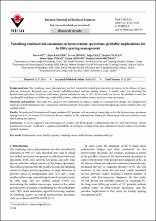Vanishing endometrial carcinoma in hysterectomy specimens: Probable implications for fertility sparing management

View/
Access
info:eu-repo/semantics/openAccessDate
2017Author
Öz, MuratKaralök, Alper
Şirvan, Levent
Taşçı, Tolga
Öcalan, Reyhan
Turan, Ahmet Taner
Güngör, Tayfun
Meydanlı, Mehmet Mutlu
Metadata
Show full item recordCitation
Öz, M., Karalök, A., Şirvan, L., Taşçı, T., Öcalan, R., Turan, A. T., Güngör, T., Meydanlı, M. M. (2017). Vanishing endometrial carcinoma in hysterectomy specimens: Probable implications for fertility sparing management. Turkish Journal of Medical Sciences, 47(6), 1744-1750.Abstract
Background/aim: The vanishing cancer phenomenon was first reported in radical prostatectomy specimens in the absence of neoadjuvant treatment. Reported cases are mostly well-differentiated and low-volume tumors. A similar entity was described for hysterectomy specimens of patients with biopsy proven endometrial cancer (EC). In this study, we discuss the probable reasons for vanishing EC and long-term follow-up results of EC patients without residual tumors in hysterectomy specimens. Materials and methods: This study was carried at two institutions in Ankara, Turkey, in a retrospective design. The computerized databases of both institutions were searched for endometrioid type EC patients whose final pathological specimens failed to show any residual tumor. Results: We evaluated 38 endometrial biopsy confirmed EC patients with no residual tumor detected in the hysterectomy specimens among a total of 224 women (17%) with the disease confined to the endometrium. During the follow-up period, no recurrences were noted among the patients. Conclusion: It can be suggested that premenopausal women with FIGO grade 1 endometrioid type EC with MRI proven “absent myometrial invasion” would have a significant probability of having no residual tumor after endometrial biopsy without any further medical treatment. © TÜBİTAK.

















